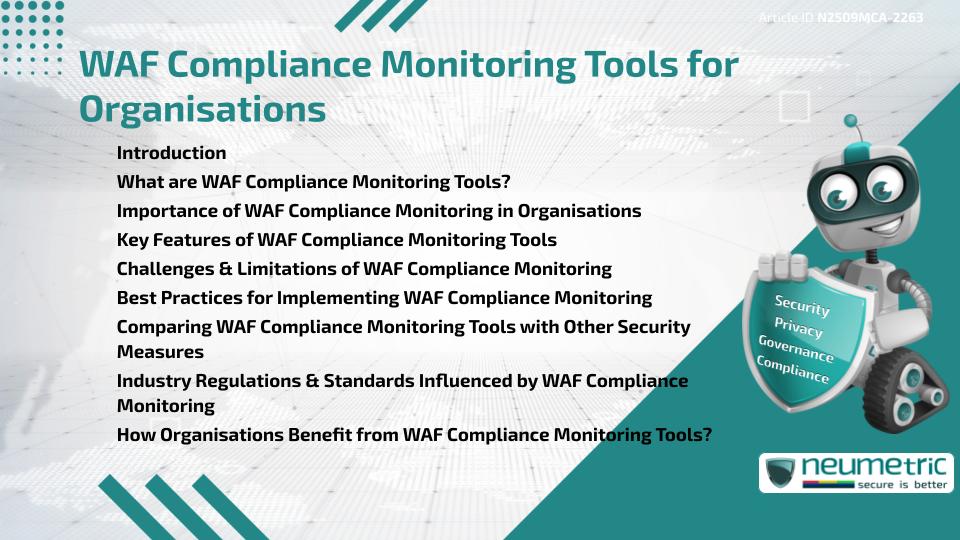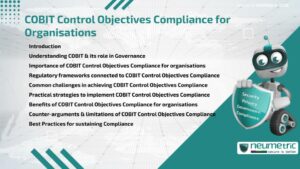Table of Contents
ToggleIntroduction
WAF compliance Monitoring Tools are essential for organisations that need to secure web applications while meeting regulatory requirements. These tools help track, assess & report on compliance with frameworks like PCI DSS, GDPR & HIPAA. By continuously monitoring traffic, detecting Threats & generating Compliance Reports, they reduce Risks while supporting legal & business obligations. Organisations use these tools to align with Industry Regulations, protect Sensitive Data & demonstrate security readiness to auditors. Without WAF compliance Monitoring Tools, gaps in security & compliance can expose organisations to penalties & reputational harm.
What are WAF Compliance Monitoring Tools?
WAF compliance Monitoring Tools are specialised solutions that integrate with Web Application Firewalls [WAFs] to track whether security configurations & practices meet compliance standards. Unlike traditional WAFs that primarily block malicious requests, these tools provide insights into how the firewall contributes to compliance goals. They generate automated logs, Audit trails & reports tailored for regulators & internal Governance teams.
Importance of WAF Compliance Monitoring in Organisations
For organisations, compliance is not optional but a legal & operational requirement. WAF compliance Monitoring Tools ensure that Sensitive Information such as Customer Data, Financial records & health information is handled securely. They help organisations prove adherence to frameworks like the Payment Card Industry Data Security Standard [PCI DSS], which requires logging & monitoring of web-based Threats.
By using these tools, organisations can show regulators & Customers that they take security seriously. This strengthens trust, reduces the Likelihood of fines & supports long-term business resilience.
Key Features of WAF Compliance Monitoring Tools
Modern WAF compliance Monitoring Tools offer a wide range of features:
- Automated reporting for audits & regulators
- Real-time Threat monitoring across web traffic
- Policy enforcement checks to ensure firewall rules align with compliance frameworks
- Centralised dashboards for visibility into compliance status
- Integration with Security Information & Event Management [SIEM] systems
These features make them far more than just traffic filters. They act as compliance enablers that streamline what would otherwise be complex, manual processes.
Challenges & Limitations of WAF Compliance Monitoring
While powerful, these tools are not without challenges. False positives can burden security teams with unnecessary alerts. Over-reliance on WAF compliance Monitoring Tools may create blind spots if other parts of the security infrastructure are weak. Additionally, licensing costs & resource requirements can be significant for small & mid-sized organisations.
It is important to recognise that these tools complement but do not replace broader security practices like Vulnerability scanning & Penetration Testing.
Best Practices for Implementing WAF Compliance Monitoring
Organisations can maximise the effectiveness of WAF compliance Monitoring Tools by following key practices:
- Regularly updating firewall Policies to reflect evolving Compliance Requirements
- Integrating WAF logs into centralised monitoring systems
- Conducting periodic reviews of Compliance Reports
- Training staff to interpret alerts & compliance metrics
These practices ensure that the tools deliver value not only during audits but also in daily operations.
Comparing WAF Compliance Monitoring Tools with Other Security Measures
Compared to intrusion detection systems or Vulnerability scanners, WAF compliance Monitoring Tools focus more on compliance alignment. They are specialised in documenting how Web Application traffic is managed according to Regulatory Standards. Other tools may identify gaps or weaknesses but often lack the structured compliance reporting that WAF compliance Monitoring Tools deliver.
In this sense, they are complementary rather than competing solutions. Organisations benefit most when these tools work as part of a layered security ecosystem.
Industry Regulations & Standards Influenced by WAF Compliance Monitoring
Several global regulations highlight the role of monitoring & reporting. For example, PCI DSS requires organisations that process payment data to monitor all access to network resources. Similarly, GDPR mandates protection of Personal Data, while HIPAA governs Healthcare Information Security.
WAF compliance Monitoring Tools provide the visibility needed to align with such frameworks. They make it easier for organisations to provide Evidence during audits & avoid penalties.
How Organisations Benefit from WAF Compliance Monitoring Tools?
The benefits extend beyond Regulatory Compliance. Organisations using WAF compliance Monitoring Tools enjoy improved Threat visibility, faster Audit preparation & stronger Customer Trust. By centralising compliance efforts, they save time & reduce operational complexity.
In industries such as Finance, Healthcare & e-commerce, these tools help organisations balance innovation with regulatory responsibility.
Takeaways
- WAF compliance Monitoring Tools track & document firewall performance against compliance standards.
- They provide automated reports, dashboards & real-time monitoring.
- Challenges include false positives & high costs for smaller organisations.
- They complement other tools like SIEM, Vulnerability scanners & IDS.
- Using them strengthens security, ensures Regulatory Compliance & builds trust.
FAQ
What is the role of WAF compliance Monitoring Tools in audits?
They generate reports & logs that demonstrate adherence to security standards, helping organisations prepare for audits with less effort.
Do WAF compliance Monitoring Tools replace traditional WAFs?
No, they extend the capabilities of traditional WAFs by focusing on compliance monitoring & reporting rather than just blocking Threats.
Which industries benefit most from WAF compliance Monitoring Tools?
Finance, Healthcare, Government & e-commerce industries benefit greatly due to strict regulatory environments & Sensitive Data handling.
How do WAF compliance Monitoring Tools integrate with existing systems?
They typically integrate with SIEM solutions, logging systems & centralised dashboards for better visibility & correlation of data.
Are WAF compliance Monitoring Tools expensive for Small Businesses?
They can be costly, but many vendors provide scalable solutions or cloud-based services that lower upfront costs for smaller organisations.
What happens if organisations ignore WAF compliance monitoring?
Without these tools, organisations Risk non-compliance penalties, reputational harm & increased Vulnerability to Cyber Threats.
How do WAF compliance Monitoring Tools reduce manual work?
By automating reports, alerts & Audit trails, they minimise the need for manual data collection & compliance documentation.
Need help for Security, Privacy, Governance & VAPT?
Neumetric provides organisations the necessary help to achieve their Cybersecurity, Compliance, Governance, Privacy, Certifications & Pentesting needs.
Organisations & Businesses, specifically those which provide SaaS & AI Solutions in the Fintech, BFSI & other regulated sectors, usually need a Cybersecurity Partner for meeting & maintaining the ongoing Security & Privacy needs & requirements of their Enterprise Clients & Privacy conscious Customers.
SOC 2, ISO 27001, ISO 42001, NIST, HIPAA, HECVAT, EU GDPR are some of the Frameworks that are served by Fusion – a SaaS, multimodular, multitenant, centralised, automated, Cybersecurity & Compliance Management system.
Neumetric also provides Expert Services for technical security which covers VAPT for Web Applications, APIs, iOS & Android Mobile Apps, Security Testing for AWS & other Cloud Environments & Cloud Infrastructure & other similar scopes.
Reach out to us by Email or filling out the Contact Form…





